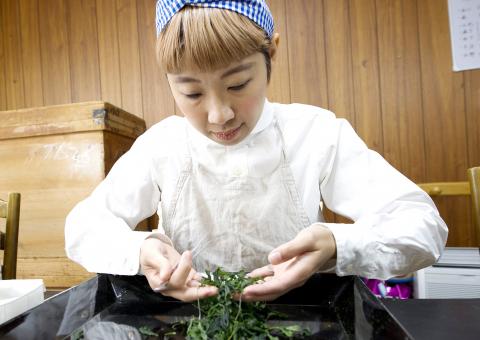A year ago, a member of a private tea society in Shanghai presented Kathy YL Chan with a small box as slender as a cigarette case. Inside were four tiles of highly prized pu-erh tea, conjoined like a chocolate bar and almost black, twined with green and ocher.
Chan, 29, who writes about tea and advises restaurants, hotels and companies on tea offerings, had mostly encountered pu-erh in the form of dense, mulchy rounds (bing cha in Mandarin), each with a crater at the center, like flattened volcanoes. The delicate box seemed a secret missive from “a darker, cooler world,” she said — what she calls, only half jokingly, the “underbelly” of tea.
The pu-erh within, from Menghai in China’s southwestern Yunnan province, near the Burmese border, was too precious to drink, Chan decided. And so she safeguards it in the kitchen of her East Village apartment, amid her considerable arsenal of teaware, including fine-spined whisks; long, skinny bamboo scoops and short, hand-hammered brass ones curved like thumbnails; a Korean teapot with a straight side handle; a ceramic bowl, or chawan, for frothing matcha, a Japanese green tea; and a paring-size knife for breaking off pieces of pu-erh, should she one day feel that she can wait no longer.

Photos: EPA
When Chan was growing up in Honolulu, tea was “not a big deal,” she said — just something that everyone in her family drank “all day, all night.” Her parents heeded the traditional Chinese belief that cold water is bad for the body and always kept an electric thermos of hot water on hand. Chan dutifully has one, too.
From her family she learned to drink tea “grandpa style:” loose leaves in a glass, into which you keep pouring water. “Your teeth are the filter,” she said. Now she supplies tea to restaurants like Eleven Madison Park, where one of her finds, ‘A’a black tea from the Big Island of Hawaii, is priced at US$65 for a rarefied, ritual Chinese tableside preparation. (This was the most expensive tea on the menu until it was recently outstripped by a vintage 1960s pu-erh.)
Sometimes Chan slips the box of pu-erh into her suitcase as a good-luck charm when she travels. The last year has taken her from the hillsides of Haleakala on Maui to the tea fields of Uji outside Kyoto, Japan. In the winter, she braved a landslide to ascend Kunlu Mountain in Yunnan, paying homage to wild pu-erh trees, some nearly a millennium old.
Like Champagne, pu-erh is a protected geographical designation; the Chinese government has mandated that only tea grown in Yunnan can be labeled pu-erh. Like Bordeaux, the longer it ages, the more coveted it is, eliciting up to tens of thousands of dollars at auction. Chan once met a collector who stood his tea cakes upright, unbrewed and undrunk, in a china cabinet, like Delft china.
Of her own untouched pu-erh, Chan admitted, “I want to drink it.” She smiled. “But I’d rather keep it as a reminder of how deep the world of tea is.”

On April 26, The Lancet published a letter from two doctors at Taichung-based China Medical University Hospital (CMUH) warning that “Taiwan’s Health Care System is on the Brink of Collapse.” The authors said that “Years of policy inaction and mismanagement of resources have led to the National Health Insurance system operating under unsustainable conditions.” The pushback was immediate. Errors in the paper were quickly identified and publicized, to discredit the authors (the hospital apologized). CNA reported that CMUH said the letter described Taiwan in 2021 as having 62 nurses per 10,000 people, when the correct number was 78 nurses per 10,000

As we live longer, our risk of cognitive impairment is increasing. How can we delay the onset of symptoms? Do we have to give up every indulgence or can small changes make a difference? We asked neurologists for tips on how to keep our brains healthy for life. TAKE CARE OF YOUR HEALTH “All of the sensible things that apply to bodily health apply to brain health,” says Suzanne O’Sullivan, a consultant in neurology at the National Hospital for Neurology and Neurosurgery in London, and the author of The Age of Diagnosis. “When you’re 20, you can get away with absolute

May 5 to May 11 What started out as friction between Taiwanese students at Taichung First High School and a Japanese head cook escalated dramatically over the first two weeks of May 1927. It began on April 30 when the cook’s wife knew that lotus starch used in that night’s dinner had rat feces in it, but failed to inform staff until the meal was already prepared. The students believed that her silence was intentional, and filed a complaint. The school’s Japanese administrators sided with the cook’s family, dismissing the students as troublemakers and clamping down on their freedoms — with

As Donald Trump’s executive order in March led to the shuttering of Voice of America (VOA) — the global broadcaster whose roots date back to the fight against Nazi propaganda — he quickly attracted support from figures not used to aligning themselves with any US administration. Trump had ordered the US Agency for Global Media, the federal agency that funds VOA and other groups promoting independent journalism overseas, to be “eliminated to the maximum extent consistent with applicable law.” The decision suddenly halted programming in 49 languages to more than 425 million people. In Moscow, Margarita Simonyan, the hardline editor-in-chief of the